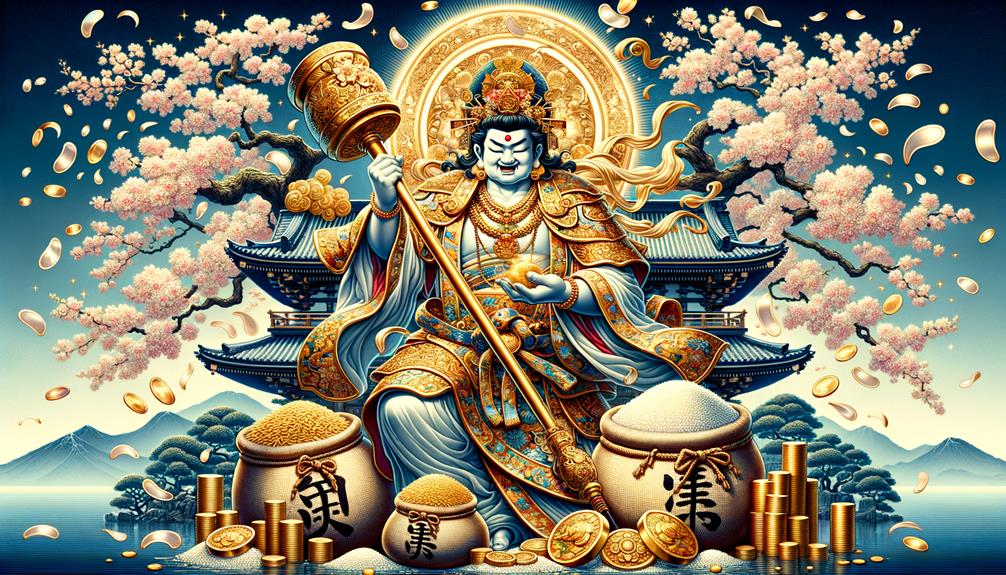In ancient Japan, a struggling farmer, facing dwindling crops, turns to the benevolent Daikokuten deity for aid. Known for his radiant smile and magical mallet, this figure embodied the journey towards prosperity. His mallet symbolized transformation, promising to change misfortune into wealth. As we explore Daikokuten's origins and significance, we'll see how his influence extends beyond mere folklore, interweaving with Japanese culture and economy. How does this deity navigate realms of myth and reality to bestow blessings?
Origins and History
Daikokuten, the revered God of Wealth, embarked on a fascinating journey from the vast landscapes of Asia to become a cornerstone of Japanese mythology. Originally a deity from Hindu and Buddhist traditions, Daikokuten's path to becoming Japan's God of Wealth took him through China and Korea before finding a permanent place in Japanese folklore during the Tokugawa period.
As one of the Seven Lucky Gods, Daikokuten symbolizes prosperity and good fortune. His connection to agriculture, specifically blessing the five cereals, highlights his role in ensuring abundance and sustenance. The iconic Mallet of Fortune in his hand represents his power to bestow wealth and happiness upon his followers.
In Japan, Daikokuten's evolution reflects a blending of various cultural and religious influences, enriching his narrative and the pantheon he belongs to. His transformation from a pan-Asian deity to a quintessential figure in Japanese mythology underscores the dynamic interplay of tradition and adaptation. Through this journey, Daikokuten became not just a symbol of material wealth but also a guardian of agricultural prosperity.
Symbolism and Attributes
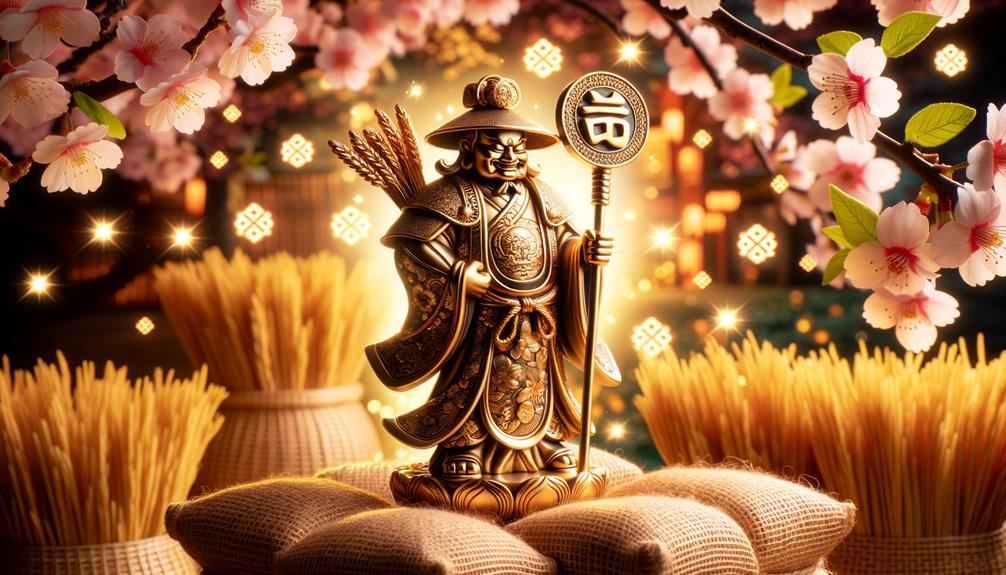
Daikokuten's iconic Mallet of Fortune symbolizes a tool for granting wishes and bringing prosperity. His Sack of Abundance represents the journey towards wealth, filled with bountiful harvests. The radiant smile he wears doesn't just convey happiness but promises good fortune to those who revere him.
Iconic Mallet of Fortune
Among Japan's mythological riches, the Mallet of Fortune represents Daikokuten's power to grant wealth and success. Wielded by the god, this magical tool materializes desired items and riches when struck on the ground, embodying Daikokuten's generosity. The mallet signifies fulfilling aspirations and invoking divine blessings, often depicted in artworks and rituals.
| Attribute | Meaning |
|---|---|
| Divine Wielding | Authority and power |
| Wish-Granting | Achieved desires |
| Riches Manifesting | Source of abundance |
| Ritual Element | Invitation for blessings |
The Mallet of Fortune encapsulates endless possibilities, an archetype of Daikokuten's benevolence transforming ordinary lives into extraordinary fortunes, as believed by the faithful.
Sack of Abundance
In mythological stories, Daikokuten's sack overflows with abundance, a tangible representation of the god's commitment to bless followers with wealth and prosperity. More than a vessel, it symbolizes bountiful harvests and endless resources under his divine influence.
The sack mirrors life's pursuit of success and affluence. Rice grains within manifest Daikokuten's blessings—each one proof of flourishing resources under his watchful eye.
Rats nibbling from the sack may seem counterintuitive, but they depict growth and wealth's cyclical nature. They convey that under Daikokuten's guidance, riches not only sustain but multiply, ensuring perpetual abundance for the faithful.
Radiant Smile Symbolism
Daikokuten's radiant, joyful smile captures his role as the god who brings good fortune. In Japanese mythology, his smiling image isn't just an expression; it symbolizes the human desire for abundance and happiness. When I see Daikokuten's wide grin, I perceive more than joy – it promises wealth, success, and his benevolent nature.
His cheerful look attracts positivity, inviting prosperity for those seeking his favor. Daikokuten's smile reflects the joy he bestows upon followers. It illustrates the abundance he brings into their lives. This benevolent quality, vividly captured in his smile, makes Daikokuten an enduring symbol of good fortune and boundless optimism. His grin confirms the joy and prosperity he promises, making his presence a cherished blessing.
Role in Japanese Culture
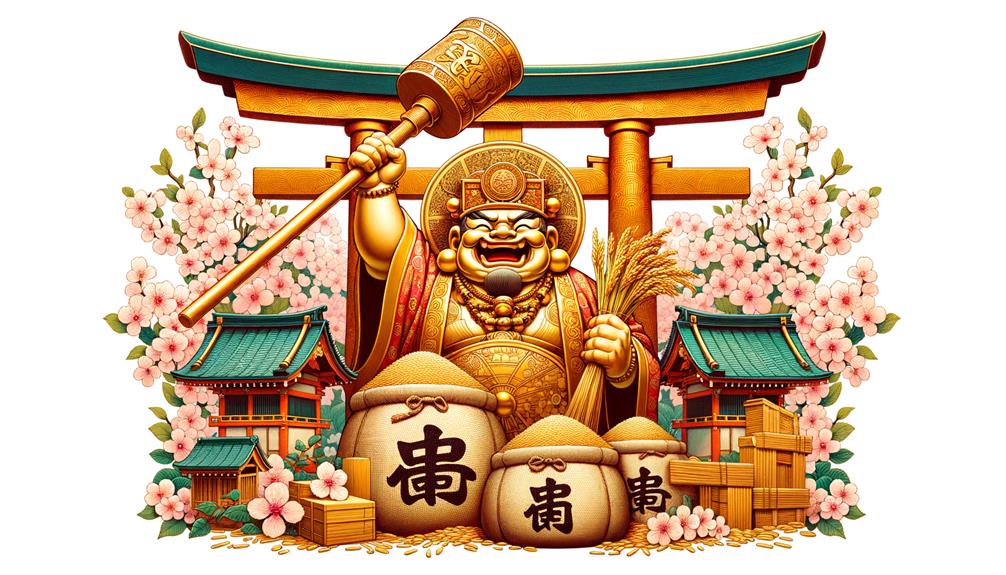
From my first encounter with Daikokuten, his role as a bringer of prosperity in Japanese culture became crystal clear. This Japanese deity, often depicted with a joyful expression, transcends symbolism – he's a prominent figure revered for his abundance and good fortune. His presence heightens during New Year's celebrations when followers make offerings and prayers, seeking his blessings for the coming year.
For farmers and merchants on their journey, Daikokuten guides them toward financial success and agricultural wealth. His blessings extend beyond material gains, instilling hope and determination to achieve prosperity. The agricultural abundance he represents holds immense cultural significance in a society deeply rooted in rice cultivation and farming traditions.
Daikokuten's influence surpasses mere fortune-bringing; he personifies the abundance that ensures a community's sustenance and happiness. Invoking his favor transforms ordinary endeavors into prosperous ones, reflecting the transformative power of belief in guiding efforts toward fruitful ends.
Iconography and Art
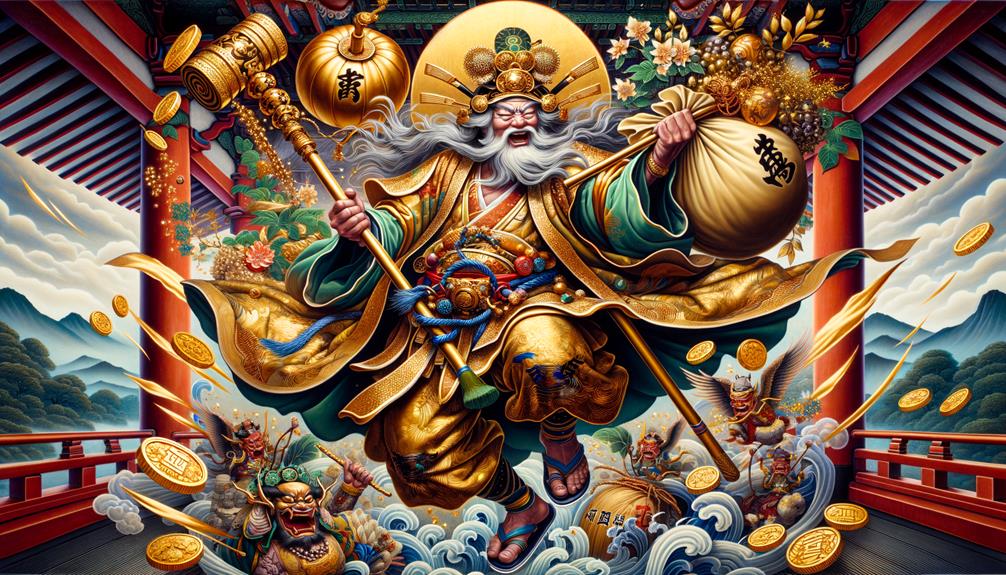
Daikokuten's artworks captivate with their intricate symbolism depicting prosperity and divine abundance. Often portrayed holding a Mallet of Fortune, this emblem signifies Daikokuten's power to grant wishes and bestow wealth. In many images, he sits atop rice bags – archetypal symbols of agricultural bounty and sustenance. Rats nibbling at the rice aren't pests, but rather symbols amplifying Daikokuten's aura of prosperity.
The bag of riches slung over his back reinforces his role as a wealthy Japanese deity. Daikokuten's iconography, initially influenced by Indian figures like Kubera and Shiva, evolved over time. He transformed into a benevolent figure synonymous with fortune and good luck. His depictions weave a rich tapestry narrating tales of abundance and fulfillment.
Rituals and Worship
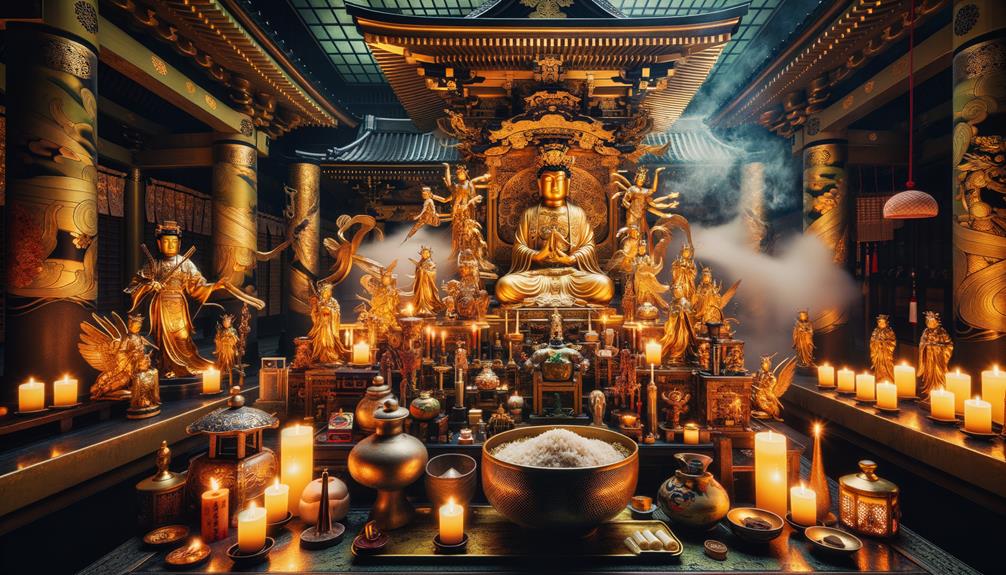
Rituals and worship around Daikokuten go beyond simple offerings of rice, grains, and sake – they represent deep reverence and aspirations for prosperity. These ceremonies, performed in temples and shrines, are like timeless tales of humanity's quest for wealth and well-being.
Worshippers clap, bow, and make heartfelt wishes, engaging in a ritualistic dialogue with the divine, seeking Daikokuten's blessings. Clapping, an archetypal symbol, aims to draw the gods' attention to earthly desires.
Statues of Daikokuten, found in homes and businesses, stand as guardians of fortune and symbols of unwavering hope. Far from mere decorations, they are focal points for daily offerings of fruits, vegetables, and incense – embodiments of gratitude and aspiration.
Special ceremonies and festivals amplify these rituals, transforming individual acts into communal celebrations of prosperity. Through these practices, Daikokuten becomes a living symbol of our shared pursuit of blessings and abundance.
Influence in Modern Times
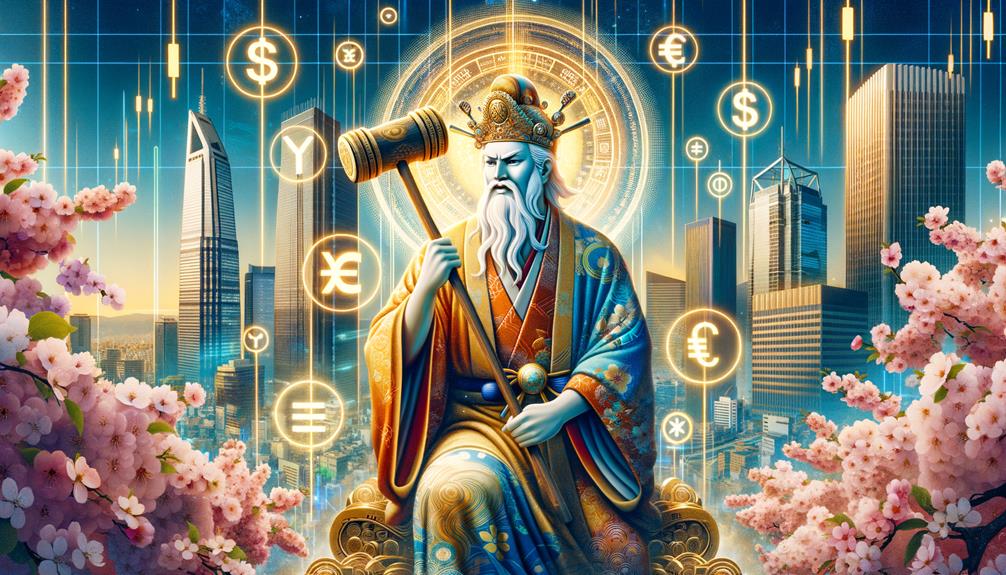
Daikokuten's role in contemporary Japan extends beyond an ancient deity. The god personifies society's perpetual pursuit of wealth and fortune, a perennial ambition transcending eras. From household altars to business rituals, Daikokuten's presence mirrors people's sustained hopes for prosperity, interweaving longstanding customs with modern dreams of success.
Cultural Symbolism Today
In contemporary Japan, the ancient deity Daikokuten maintains a strong presence as a symbol of prosperity and financial success. Known as the Great Black Heavens, this mythological figure resonates deeply within cultural practices. Individuals frequently make offerings and prayers to Daikokuten, rituals believed to attract wealth and abundance.
Across Japan, temples and shrines dedicated to Daikokuten draw worshippers seeking good fortune. These spaces transport visitors to a mythical realm where Daikokuten's archetype inspires modern aspirations. The act of presenting rice or coins reflects a longstanding belief in this deity's ability to bestow prosperity.
Daikokuten's enduring popularity underscores the timeless pursuit of economic security. His image, often depicting a treasure sack and mallet, exemplifies society's collective yearning for material wealth. As mythology converges with contemporary desires, Daikokuten remains an integral symbol of cultural identity and financial aspirations.
Economic Ritual Practices
In today's world, ancient rituals invoking Daikokuten have become integral to our pursuit of prosperity, blending age-old traditions with modern ambitions. Businesses and individuals seeking financial success turn to this deity, the symbolic representation of wealth and good fortune. These ceremonies, steeped in centuries-old practices, offer a bridge between the mystical and the material, grounding our aspirations in time-honored customs.
Companies and individuals alike perform rituals dedicated to Daikokuten, making offerings to attract prosperity and economic growth. Whether a small business owner lights incense before a statue or a corporate executive organizes a formal ceremony, these acts exude reverence and hope. Offerings like rice or coins symbolize our desire for financial success and abundance.
Frequently Asked Questions
What Is Daikokuten the God Of?
Daikokuten, the Japanese deity, symbolizes prosperity in agriculture, wealth, and overall abundance. Farmers turn to this god for bountiful harvests, while businesses seek their share of success and fulfillment under Daikokuten's auspicious presence.
What Does the Daikokuten Symbolize?
Daikokuten embodies bounty and prosperity – a symbol of our pursuit of wealth, success, and life's riches. Through his wondrous mallet and treasures, he represents the hero's journey toward financial growth and agricultural abundance.
Who Are the Seven Gods of Wealth?
The Seven Lucky Gods, or Shichi-fuku-jin, symbolize prosperity in Japanese culture. Each deity represents unique aspects of fortune, guiding us on a journey towards abundance and well-being.
Ebisu, the laughing fisherman, brings commercial success and a bountiful catch. Daikoku, the wealthy farmer, bestows prosperity through diligence. Bishamonten, the warrior monk, protects against adversity while fostering fortune.
Benzaiten, the goddess of music and knowledge, grants artistic and academic riches. Fukurokuju, the longevity deity, embodies contentment in old age. Jurōjin, the Shinto god, offers long life filled with happiness.
Lastly, Hotei, the cheerful Buddha, symbolizes generosity and overflowing abundance. Together, these deities embody paths to fulfillment in all aspects of life.
Is Zerofuku a Real God?
Like a mythical hero springing from pure imagination, Zerofuku isn't a deity worshipped in religion, but rather an artistic creation by Yoshitaka Amano. Born from the fictional world of the 'Heroic Legend of Arslan,' Zerofuku represents good fortune and luck through Amano's vivid artistic vision.

